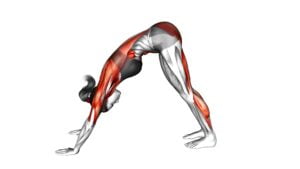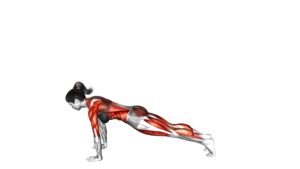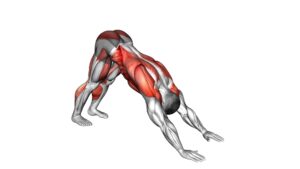Alternating Leg Downward Dog (male) – Video Exercise Guide & Tips

Looking to improve your yoga practice? Try the alternating leg downward dog!
Watch This Exercise Video
This video exercise guide and tips specifically designed for men will help you benefit from proper alignment and avoid common mistakes.
With modifications and variations for all levels, you can easily tailor this pose to your needs.
Follow our expert advice and get ready for a successful and rewarding practice.
Key Takeaways
- Alternating Leg Downward Dog improves flexibility and mobility, especially in the hamstrings, calves, and shoulders.
- Engaging in this exercise strengthens the core muscles, including the abdominal muscles, lower back, and obliques, leading to improved posture and physical performance.
- Practicing Alternating Leg Downward Dog enhances balance, coordination, and body awareness, making it beneficial for athletes and dancers.
- Male practitioners should focus on maintaining proper alignment from hands to hips to reduce strain on the wrists and shoulders, accommodate physical limitations, and prevent injury.
Benefits of Alternating Leg Downward Dog
You can experience several benefits by regularly practicing Alternating Leg Downward Dog. One of the main benefits is the improvement in flexibility and mobility. This pose stretches your hamstrings, calves, and shoulders, helping to increase your overall range of motion. By consistently practicing Alternating Leg Downward Dog, you can gradually increase your flexibility and make everyday movements easier.
Another benefit of this pose is the core strengthening and stability it provides. As you lift one leg off the ground and hold the position, your core muscles are engaged to maintain balance and stability. This helps to strengthen your abdominal muscles, lower back, and obliques. A stronger core not only improves your posture but also enhances your overall physical performance.
In addition to flexibility and core strength, practicing Alternating Leg Downward Dog can also improve your balance and coordination. By focusing on maintaining proper alignment and evenly distributing your weight, you train your body to stay balanced and coordinated. This can be particularly beneficial for athletes, dancers, and individuals looking to improve their body awareness.
Proper Alignment for Male Practitioners
To ensure proper alignment for male practitioners, focus on maintaining a straight line from your hands to your hips in the Alternating Leg Downward Dog pose. Gender differences in yoga practice may lead to variations in body structure and flexibility, which can affect alignment. Male practitioners may have different physical limitations compared to their female counterparts, and it's important to address these differences to prevent injury and maximize the benefits of the pose.
In the Alternating Leg Downward Dog pose, start in a high plank position with your hands shoulder-width apart. As you lift your hips up and back, actively engage your core and press your heels toward the ground. Pay attention to the alignment of your hands, wrists, and shoulders to maintain a straight line. This alignment ensures that your weight is evenly distributed and reduces strain on your wrists and shoulders.
For male practitioners, it's common to have tighter hamstrings and less flexibility in the hips. To address these physical limitations, you can bend your knees slightly and focus on lengthening your spine. This modification allows you to maintain the straight line from your hands to your hips, even if your heels don't touch the ground.
Modifications and Variations for All Levels
To further enhance your practice and accommodate practitioners of all levels, explore modifications and variations in the Alternating Leg Downward Dog pose. Here are some ideas to help you modify the pose if you're a beginner or challenge yourself with advanced variations:
- Modifications for beginners:
- Use yoga blocks: If reaching the floor is difficult, place yoga blocks under your hands for added support and stability.
- Bend your knees: Consider bending your knees slightly to make the pose more accessible and reduce strain on your hamstrings.
- Take breaks: Feel free to come down to Child's Pose whenever you need to rest or catch your breath.
- Advanced variations:
- Lift one leg: While in the Downward Dog pose, try lifting one leg off the ground and reaching it towards the sky. This variation engages the core and challenges your balance.
- Add twists: From the Downward Dog pose, take one hand and reach it towards the opposite ankle. This variation adds a twist to the pose, targeting the obliques and improving spinal mobility.
- Incorporate push-ups: From the Downward Dog pose, lower your body into a push-up position and then return to the starting position. This advanced variation adds an upper body strengthening element to the pose.
Remember to listen to your body and choose modifications or variations that feel comfortable and safe for you. Enjoy exploring different options to enhance your Alternating Leg Downward Dog practice.
Common Mistakes to Avoid
One common mistake to avoid when practicing the Alternating Leg Downward Dog pose is forgetting to engage your core for stability and balance. Proper form is crucial for maximizing the benefits of this pose and preventing injury. Engaging your core muscles helps to stabilize your body and maintain a straight line from your hands to your hips. Without this engagement, you may find it difficult to maintain balance and may put unnecessary strain on your shoulders and lower back.
Another common mistake is allowing your shoulders to collapse and your head to hang. When performing the Alternating Leg Downward Dog, it's important to keep your shoulders engaged and your head in line with your spine. This helps to maintain proper alignment and prevents strain on your neck and shoulders.
Additionally, be mindful of your breath during the pose. It's common to hold your breath or breathe shallowly when in a challenging position. Remember to take deep, steady breaths throughout the pose to help relax your body and increase your focus.
Lastly, avoid rushing through the pose. Take your time to properly align your body and find stability before moving to the next position. Rushing can lead to improper form and decrease the effectiveness of the exercise.
Tips for a Successful Practice
Maximize the effectiveness of your practice by focusing on consistency and mindfulness. To help you enjoy and get the most out of your yoga sessions, here are some tips for a successful practice:
- Breathing techniques for better focus:
- Practice deep belly breathing to calm your mind and center yourself.
- Use ujjayi breathing, also known as victorious breath, to create a steady and rhythmic flow of breath.
- Incorporate breath retention techniques, such as alternate nostril breathing, to improve focus and balance.
- Warm-up exercises for a successful practice:
- Start with gentle stretches to warm up your muscles and increase flexibility.
- Incorporate dynamic movements like sun salutations to warm up your entire body.
- Include joint mobilization exercises to improve range of motion and prevent injuries.
By integrating these breathing techniques and warm-up exercises into your yoga practice, you can enhance your focus, prevent injuries, and improve your overall performance.
Remember to listen to your body, take breaks when needed, and practice with mindfulness and intention. With consistency and dedication, you'll reap the many benefits of a successful yoga practice.
Frequently Asked Questions
How Long Should I Hold Each Leg in the Alternating Leg Downward Dog Position?
When doing the alternating leg downward dog, it's important to hold each leg for an equal amount of time to maintain balance and symmetry. Aim to hold each leg for around 5-10 breaths or about 30-60 seconds.
This will give your body enough time to stretch and strengthen your muscles while also providing the benefits of the pose, such as improved flexibility and stability.
Remember to listen to your body and adjust the duration as needed.
Can Alternating Leg Downward Dog Help With Lower Back Pain?
Alternating leg downward dog can be beneficial for relieving lower back pain. By stretching and strengthening the muscles in your back, it can help improve flexibility and overall strength.
To modify this exercise for beginners or those with limited mobility, you can use props like blocks or a chair for support. It's important to listen to your body and only go as far as feels comfortable.
Regular practice of this pose can contribute to a healthier back.
Is It Safe for Pregnant Women to Practice the Alternating Leg Downward Dog?
During pregnancy, it's important to prioritize the safety of both you and your baby. Prenatal yoga can offer numerous benefits for pregnant women, including improved flexibility and reduced back pain.
However, certain modifications are necessary for common yoga poses, such as downward dog, to accommodate your changing body.
It's always a good idea to consult with a qualified prenatal yoga instructor who can guide you in making the necessary modifications to ensure a safe and enjoyable practice.
Can Alternating Leg Downward Dog Improve Flexibility in the Hamstrings?
Alternating leg downward dog is a great exercise to improve hamstring flexibility. By stretching one leg at a time, you can target and lengthen the muscles in your hamstrings.
This exercise helps to increase range of motion and improve overall flexibility. The benefits of alternating leg downward dog include reducing muscle tightness, improving posture, and enhancing athletic performance.
Are There Any Specific Breathing Techniques That Should Be Used During the Alternating Leg Downward Dog Pose?
During the alternating leg downward dog pose, it's important to focus on your breath. By inhaling deeply and exhaling fully, you can enhance your body's flexibility and stability.
Proper breathing techniques can help you stay grounded and centered throughout the pose, allowing for a deeper stretch in the hamstrings and increased balance.
Incorporating conscious breathing into your practice can also promote relaxation and mindfulness, improving overall well-being.
Conclusion
In conclusion, the alternating leg downward dog is a beneficial exercise for male practitioners. It helps improve flexibility, strength, and balance.
By ensuring proper alignment and making modifications as needed, practitioners of all levels can safely practice this pose. It's important to avoid common mistakes and follow the provided tips for a successful practice.
Incorporating this exercise into your routine can contribute to overall physical well-being.

Author
Years ago, the spark of my life’s passion ignited in my mind the moment I stepped into the local gym for the first time. The inaugural bead of perspiration, the initial endeavor, the very first surge of endorphins, and a sense of pride that washed over me post-workout marked the beginning of my deep-seated interest in strength sports, fitness, and sports nutrition. This very curiosity blossomed rapidly into a profound fascination, propelling me to earn a Master’s degree in Physical Education from the Academy of Physical Education in Krakow, followed by a Sports Manager diploma from the Jagiellonian University. My journey of growth led me to gain more specialized qualifications, such as being a certified personal trainer with a focus on sports dietetics, a lifeguard, and an instructor for wellness and corrective gymnastics. Theoretical knowledge paired seamlessly with practical experience, reinforcing my belief that the transformation of individuals under my guidance was also a reflection of my personal growth. This belief holds true even today. Each day, I strive to push the boundaries and explore new realms. These realms gently elevate me to greater heights. The unique combination of passion for my field and the continuous quest for growth fuels my drive to break new ground.







